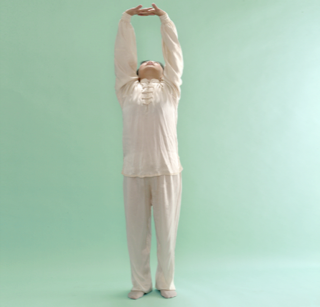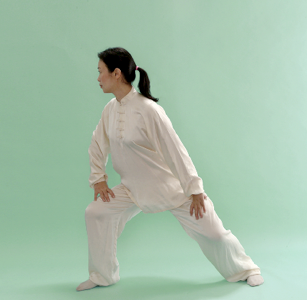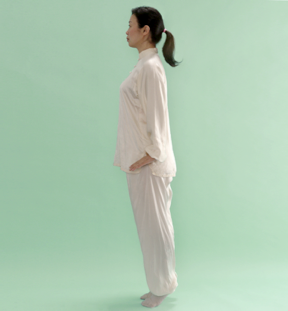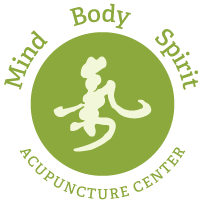Introduction to Qigong
1. A brief history of qigong
Qigong is the key component of traditional Chinese medicine with a history of five thousand years (in record), which can be divided approximately into four major periods.
(1) The period of united heaven, earth and man (before 206 BC): This period was marked out historically by the book “Yi Jing” (Book of Changes) introduced in 1122 BC, which talked about Qi, the concepts of the natural energies and the integration of Heaven, Earth, and Man.
(2) The period of Qigong mixed with religion (206 BC – 500 AD): During Han dynasty (206 BC) Buddhism and meditation methods were imported from India, which brought Qigong practice and meditation into the religious Qigong era.
(3) The period of martial art Qigong (500 AD –): In the Liang dynasty (502- 557 Ad), it was discovered that Qigong could be used for martial-art purposes. From 1911 on, Chinese Qigong training was mixed with Qigong practices from India, Japan and many other countries because of the ease of communication in the modern world.
(4) The period of modern Qigong research: (1980s – present). As more and more Qigong practitioners came out to show the public their amazing abilities and to teach the public to practice Qigong, it gradually emerged from the traditional secret transmission into a practice found in the public domain and scientific research.
2. Definition of qi and qigong
(1). What is Qi
• Heaven Qi: made up of forces which heavenly bodies exert on the earth, such as sunshine, moonlight, and the moon’s affect on the tides.
• Earth Qi: absorbs the heaven qi, and is influenced by it.
• Human Qi: influenced by the heaven and earth qi.
(2). What is Dan Tian
The Dan Tian is a spot around a couple of inches below the navel, and located inside the body. It is where a martial artist’s power comes from. The Dan Tian is sometimes divided into sections.
• Lower Dan Tian: associated with physical energy, and sometimes sexuality.
• Middle Dan Tian: deals with respiration and the health of internal organs.
• Upper Dan Tian: relates to the consciousness, or shen, and your brain.
(3). The three treasures-Jing(essence), Qi, and Shen(spirit)
• Essence: the most original and refined part of every thing.
• Qi: the internal energy of your body.
• Shen(Spirit): the center of the mind.
(4). What is qigong
Qigong is an ancient Chinese health care system that integrates physical postures, breathing techniques and focused intention.
The word Qigong (pronounced chi kung) is a combination of two ideas: “Qi” means air, breath of life, or vital energy of the body, and “gong” means the skill of working with, or cultivating, self-discipline and achievement. The art of Qigong consists primarily of meditation, relaxation, physical movement, mind-body integration, and breathing exercises. Practitioners of Qigong develop an awareness of qi sensations (energy) in their body and use their mind to guide the Qi. When the practitioners achieve a sufficient skill level (master), they can direct or emit external Qi for the purpose of healing others.
In traditional Chinese medicine, good health is a result of a free flowing, well-balanced energy system. It is believed that regular practice of Qigong helps to cleanse the body of toxins, restore energy, reduce stress and anxiety, and help individuals maintain a healthy and active lifestyle.
(5). Different type of qigong
A. Quient qigong:
B. Dynamic qigong: Ba duan jing, Taichi
There are many different types of Qi gong exercises and many new forms are being devised. The basic concept behind Qi gong is the mindful harmonization of body, mind, and spirit in a focused manner. Hence, whether the Qi gong requires movement or stillness meditation, the body is relaxed and the mind is focused on specific ideas or parts of the body. One of the most common areas of focus is below the navel and is known as the Tan Tian, which is thought to be a major energy center. Chinese medicine holds that when the body and mind are harmonized through the practice of Qi gong, the Qi can be generated, blockages of Qi can be released, and health increases.
Some Qi gong styles involve movements that may be combined into graceful forms such as Tai Qi Quan or the Eight Pieces of Brocade, both which have become a popular exercise for promoting health and reducing stress. Other types of Qi gong involve meditation and visualization exercises on a specific Zang Fu Organ, Meridian, or even sounds and colors to achieve therapeutic effects in the body. Another type of Qi gong involves massaging a specific part of the body while concentrating on balancing the Qi in that area. Qi gong exercises may be performed standing, sitting, or lying down. Most Qi gong traditions recommend that individuals practice once or twice a day for general health prevention. Patients with specific disorders who have been assigned Qi gong exercises to correct a Pattern of Disharmony may practice more frequently.
(6). Qigong training theory
• Regulating the “Shen” (mind and spirit): It refers to the regulation of the mind into a quiet and relaxed state. It helps to increase the coordination of the central nervous system.
• Adjusting the breath: There are many styles of breathing technique. They are natural breathing, chest breathing, normal abdominal breathing, reverse abdominal breathing, breath retention, skin breathing, transport breathing, sun breathing, bone breathing, palm and sole breathing, and more. Correct breathing has 8 qualities: silent, fine, long, slow, deep, soft, even or continuous.
A. Nature breathing:
Natural breathing is the beginner’s breath. Rather than controlling your breathing, first simply observe your breath and feel its natural movement in your body. Next, as you inhale, breathe down into your lower lungs. This will push your diaphragm down and expand your abdomen. Breathe to about 70-80% of your lung’s capacity. Forcing yourself to fully expand your lungs may cause tension in your rib cage which is counter productive. After your inhalation reaches its peak, exhale smoothly and allow your diaphragm to relax. As your exhalation begins to reach its end, gently contract your abdominal muscles pulling in your stomach slightly.
B. Abdominal breathing:
Through deep and gentle abdominal breathing exercises, oxygen intake of the lungs dramatically increases. Thus, the cardiovascular and other essential systems of the body are strengthened. In particular, this abdominal style of breathing creates a stimulating function of the internal organs, which would result in the increase of blood circulation to the organs, secretion of the digestive system, and movement of the stomach and intestines to improve absorption of nutrients.
The following 8 qualities are important in developing your breath:
• Silent: keep your breath as quiet as possible by breathing slowly and smoothly.
• Fine: breathing through your nose or mouth should be fine like a breeze, not choppy and rough.
• Slow: breathing should follow an even timing. Don’t rush to the next breath. If you are running out of breath, take a few sips of air to keep the oxygen flow going and then adjust your breathing so that it is comfortable.
• Deep: remain as relaxed as possible to avoid muscular tension in the chest. This will allow you to breathe deeply with your diaphragm.
• Long: breathing deeply and slowly will make your breath long. One key reason why we do rhythmic arm movements is to train one in long, slow deep breathing.
• Soft-relaxed: keep your body soft and relaxed while you breath.
• Continuous-rhythm: each inhalation flows naturally into the exhalation. Note: Other breathing styles may retain (hold) their breath for a period. However, this is not the case with the beginner’s natural breathing.
• Even: keep the length of your inhalation and exhalations about the same time.
• Improvement of the body: This refers to the body’s posture and movement through exercise and self-massage. The effects of qigong are slow and gentle. In addition, qigong requires a close coordination of motion, mind, and breath, which would be helpful in increasing blood circulation and correcting functional disturbances.
(7). Zhan Zhuang (Standing pole)
Zhan Zhuang is an integral aspect to any traditional Qi Gong system. This Qi Gong includes standing positions that develop rooting and grounding to the earth.
1). Basic Standing Posture: Wu Ji Empty Posture (Wu Ji Zhuang)
• Stand up in a relaxed manner.
• Your feet should be separated from 6″ to 18″. Both of you feet should be pointed straight ahead and flat on the floor.
• Relax your body
• Clear your mind.
• Keep a pleasant look on your face – a soft gentle smile is beneficial.
• Keep your head up and look forward.
• Your eyes should be open, with a soft and wide angle focus.
• Breathe in and out in a relaxed, easy, and regular manner. Use the abdominal breathing Breathe deeply and exhale fully. Breathe in through your nose and out through your mouth. Keep your lips parted slightly. Breathing should be natural, relaxed, and not requiring your attention.
• Your arms should hang down in a relaxed manner at your sides
• Relax the shoulders and let them hang down.
This posture is often called the “Wu Ji” posture in Taijiquan. It is the resting position, the position before any motion begins a state of “grand emptiness.” It is the primordial condition – empty, free, motionless, without qualities. It precedes the movement of Yin/Yang both logically and temporally. The classics talk of Wu Ji giving birth to Tai Ji, emptiness transforming itself into the manifold of cyclic dualities. We should note that this posture is very similar to the Yoga posture of Tadasana – the Mountain Pose. We should stand like a Mountain: strong, stable, unmoving, grand, still, aloof, above the mundane, powerful, accepting but unbroken by the storms of ideas, and avalanches of strong emotions
2). Embracing Posture (Ping Bu Cheng Bao Zhuang)
Start in the Empty Posture as described above. When you have settled down and feel calm, lift your arms slowly in front of you in a shape of embracing a big balloon in front of your chest. The hands should be in front of your shoulders, with the palms facing you and the fingers of both hands pointing at each other. Keep your fingers open and imagine small cotton pads placed between fingers, supporting them in their open position. Your hands are soft and slightly curved. Feel your elbows resting on soft pillows.
With practice, you will be able to achieve a very relaxed feeling. When that happens, you can move on to the next step, creating kinaesthetic images.
Up to now, your elbows were as if resting on soft pillows, keeping your shoulders relaxed. Now imagine that your elbows are touching balloons floating on water. Your task is to keep the balloons under your elbows. If you lift your elbows, the balloons will be free to float away. If you press a little more, they will be pressed into the water and pop out to float away again. Imagine that the big balloon you are embracing is very fragile and filled with helium – if you press a little more, it will burst, if you press a little less, it will float away. The feeling created is that of sticking very lightly to the balloon but making sure not to let it slip from your embrace. The purpose of these types of images is not to become skilful in creating them but in exploring how the body feeling changes and gradually becoming aware of the inside body structure and body’s unity. You can start slowly swaying forward and back. Keep your body balanced and experience the movement as a passive movement; for example as if standing in a slowly flowing river that keeps changing its direction. As you get better in experiencing the ‘inner flow’ within your body, you can discard the images.
3). Covering Posture (Ping Bu Fu An Zhuang)
From the Embracing Posture, keeping your elbows still, slowly lower your forearms and turn your hands palms down. The arms should be horizontal, with fingers of each hand pointing inwards at around 45 degrees angle. Feel as if your arms and hands are resting on a plank of wood that is floating on water. Feel the plank floating on water away from you and follow that motion with your body. There should not be any change of your arms in relation to your body. Then feel the plank floating towards you and again follow the motion. All other points remain the same.
4). Combat Postures
Practice of Combat Postures is the first step in acquiring Internal Power. Their role is to make the Combat Stance seem as natural as possible, strengthen legs and create a connection between them, and start using the whole-body connection to ‘sense strength’ in the body.
5). Combat Stance
Stand with your heels about fist-width apart, toes pointing slightly out. Transfer your weight onto your right leg and shift the left foot forward, in the direction the foot is pointing and lift the front heel off the ground. Put about a quarter to a third of your weight onto the front foot. Keep a slight push from the front foot into the back one and vice versa. Each of your knees should point in the same direction as the respective foot. Feel as if there is an elastic band between the front toes and your forehead and between the front knee and the opposite hip. At all times feel that you are holding these elastic bands slightly stretched. The body should be held as described for the Health Postures. Eyes should be open, looking into distance.
6). Almost-Movement
Observe closely what happens in your body just before you move. Say you get ready to move but you ‘abort’ the move just before it actually happens. If you try it few times, you are quite likely to notice a certain type of feeling in the part of the body that you were going to move. At the beginning, it is probably easier to feel it in your hands or arms, so if you have difficulty with it, choose a hand movement. Eventually you will be able to feel a sort of ‘inner’ activity in your body. What happens is that as you form an intention to move and as you get ready to move, there will be some muscular activity associated with stabilizing your body in such a way so as to enable the movement to take place. Normally this muscular activity is not noticed as it gets subsumed in the sensations of the actual move that normally takes place. We can’t call it a movement, as there is nothing actually moving yet it is more than ‘not moving’ – that’s why I call it almost-movement. This is the basis of ‘sensing strength’. In the following Zhan Zhuang exercise we practice moving or sensing in forward-back direction.
7). ‘Primordial Void’ Posture (Hun Yuan Zhuang)
Stand in a Combat Stance and as in the Health Postures above, create some image in your mind that will make you calm and happy; keep it in your mind and your body throughout the training. Slowly lift your arms in front of you as in the Embracing Posture described above but this time the left hand (assuming the left foot is in front) is slightly more forward and up than the right hand. Apart from the position of your arms and legs, the rest should be the same as in the Embracing Posture (including creation of a calm and peaceful feeling).
8). Sensing Strength in a Forward-Back Direction
Keep a very soft and relaxed body structure and create a kinaesthetic image of exerting a great deal of strength. For example, imagine that you are embracing a tree and try to uproot it by pushing with your body forwards. At the same time, imagine that you are inside another, hollow, tree with your arms and the back in contact with the tree and you try to uproot that one by pushing with the back of your arms. Alternate this effort with ‘moving’ in the opposite direction – pulling the inside tree with your arms and pushing the outside tree with the back of your body. Always use the whole body. Do not imagine that you are actually succeeding in any of these tasks – the trees are too big and just won’t budge. During your practice, you stay relaxed and nearly still with perhaps just very small movement. Little by little you will get a feeling of almost-movement.
After a period of practice (say several weeks), slowly work the following six points into your posture:
• lift your foot arches and feel as if your feet are grasping the ground
• feel your pelvis horizontal and from there a slight lifting of your perineum
• feel your diaphragm horizontal by relaxing down the front bottom edge of your ribcage which should fill-out your lower back (“relax your chest and raise the back”)
• feel the top of the chest/bottom of your neck horizontal
• feel the bottom of your mouth relaxed and horizontal
• feel the top of your head horizontal
Tips for Zhan Zhuang practice
1). Establish a regular routine
The best way to achieve that is to start with very little but every day. What is ‘very little’? Say 10 seconds – and I do not mean it as a joke! If you start with 10 seconds, you’ll eventually be able to go to hours with no problem (if you wish).
2). In Zhan Zhuang you are training your Mind
The best way to train your mind is to practice only when you concentrate. That’s why 10 seconds is probably a good starting point. As you keep practicing, you naturally start to concentrate for longer and so you practice longer. Even when you can stand for a long time, if one day you can’t concentrate, stop practicing. If you force yourself to stand for a set period, you learn not to concentrate, the practice becomes boring and soon you would give up. When you concentrate, it’s enjoyable and you progress faster.
3). Pain is not necessary
Pain is distracting. Remember, you are training your mind – if the pain in your legs or arms distracts you, you can’t concentrate, so stop practicing or change to another posture. If you have pain in any of your joints, stop practicing – you should never feel pain in your joints. Muscle pain could be OK, but best to check with someone who would know (for example your teacher).
(8). Ba Duan Jing (The Golden Eight Exercises)
The Golden eight exercises is a kind of dynamic qigong practice. It is derived from one of the oldest health strengthening exercises in China which was creates 800 years ago.
Ba Duan Jing consists of two styles: sitting and standing type.
• Sitting Ba Duan Jing (Golden Eight Exercises)
The sedentary style adopts a sitting position with concentrated mind and attention to one’s breathing. This particular type incorporates knocking teeth, shaking head, gargling throat, massaging the kidney area, swaying shoulder, pressing the scalp, stretching the sole of the foot, etc.
• Standing Ba Duan Jing (Golden Eight Exercises)
The active style adopts a standing position emphasizing body movement.
Sitting Ba Duan Jing (Golden Eight Exercises)
Form1:
Strike Teeth in deep Meditation
1. Sit still in deep meditation, legs crossed, and hands loosely clench.
2. Strike upper teeth with lower teeth 36 times.
3. Interlock fingers behind head, and focus on breathing rather than on external event. Take nine deep breathes.
4. Move hand to cover ears, and tap back of head 24 times with middle finger pressed under index finger.
Form 2
Shake the Heavenly Pillar
1. Sit with legs crossed, back and shoulders are straight, but relax.
2. Join hands in front of belly.
3. Slowly shake head and shoulders to left and right 24 times, and focus on breathing.
Form 3
Gargle with Saliva
1. Sit with legs crossed, back and shoulders are straight, but relax.
2. Raise hands over head.
3. Stir tongue 36 times between hard and soft palates to produce a mouthful of saliva.
4. Swallow it in three gulps, as if forcing something hard down throat.
Form 4
Massage Lower Back
1. Sit with legs crossed, back and shoulders are straight, but relax.
2. Rub hands together until warm.
3. Slowly massage lower back with both hands 36 times.
4. Return hands to front and loosely clenched.
5. Imagine that a fire is spreading from heart to lower elixir field
Form 5
Rotate Single Hand on Waist Side
1. Sit with legs crossed, back and shoulders are straight, but relax.
2. Rotate left shoulder 36 times with back of right hand on lower back.
3. Then, rotate right shoulder 36 times with back of left hand on lower back.
Form 6
Rotate Both Hands on Waist Sides
1. Sit with legs crossed, back and shoulders are straight, but relax.
2. Rotate shoulders simultaneously 36 times with both palms on lower back.
3. Imagine that a fire is spreading from back to head.
4. Stretch out both legs when you feel that you’ve taken in enough fresh air through nose.
Form 7
Prop Heaven with Both Hands
1. Sit with legs crossed, back and shoulders are straight, but relax.
2. Rub hands as you breathe out air five times through opened mouth.
3. Palms up, raise hands over head 3 or 9 times with fingers interlocked..
Form 8
Grasp Feet
1. Sit up with legs stretched out in front, feet shoulder width apart.
2. Grasp middle part of both soles with separate hands and pull feet 12 times.
3. Then sit upright with legs crossed.
4. Gargle mouth with saliva, then swallow gathered saliva in three gulps.
5. Join hands in front of belly and shake head and shoulders to left and right 24 times, eyes looking in same direction.
6. Rotate shoulders simultaneously 24 times with both palms on lower back.
7. Hold breath now and then as you imagine that a fire is spreading from lower elixir to whole body.
Standing Ba Duan Jing (Golden Eight Exercises)
A song of Ba Duan Jing (Golden Eight Exercises):
1. Holding heaven in the palms benefits the whole body
2. Opening the bow in the both sides just like shooting culture
3. Moving hands regulates the Spleen and Stomach
4. looking backward repels consumptions and injury
5. Shaking the head and waving arms get rid of internal heat
6. Making fists and staring angrily increase strength
7. Raising the head and reaching the feet protests the Kidney and
8. Lifting the heels and shaking the body dispels various disease









